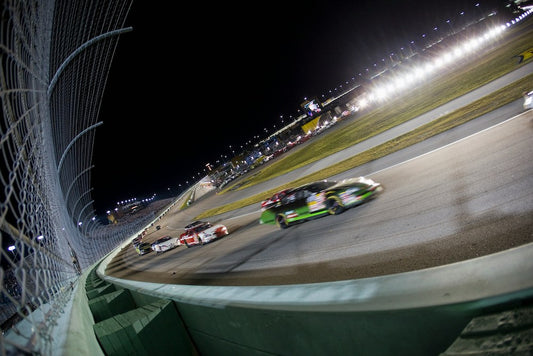The Evolution and Mechanism of NASCAR's Playoff System

The Beginning of the Playoff System
Back in 2004, NASCAR introduced the playoff system known as the "Chase for the Nextel Cup." The purpose of this system was to add excitement and drama to the end of the season, ensuring that every race mattered in the battle for the championship. Instead of the season-long points system, the playoff system condensed the championship battle into a 10-race playoff.
The playoff system was designed to create a more intense and competitive end to the season. By resetting the points for the top 10 drivers and allowing them to compete for the championship in a series of races, NASCAR aimed to increase fan engagement and create memorable moments on the track.
Under the initial playoff system, the top 10 drivers in the regular season standings would have their points reset to 5,000. In addition, each driver would receive bonus points based on their regular-season performance. The playoff consisted of 10 races, with the driver who accumulated the most points at the end being crowned the champion.
In 2004, Kurt Busch became the first champion under the playoff system. He outperformed his competitors in the 10-race playoff, securing the championship title and cementing his place in NASCAR history.
Changes and Evolution of the Playoff System
In 2014, NASCAR made significant changes to the playoff system, introducing the "Chase for the Sprint Cup." This new format placed an emphasis on winning and introduced elimination rounds to increase the intensity and drama of the playoffs.
Under the new playoff system, winning became even more critical. NASCAR implemented a series of elimination rounds, with four drivers being eliminated after every three races. This meant that a driver's performance in each round was crucial, as a bad race could result in elimination from the championship battle.
The introduction of elimination rounds and the emphasis on winning sparked controversy and criticism among fans and drivers. Some argued that the new system placed too much emphasis on individual races rather than consistent performance throughout the season. Others felt that the playoff system undermined the importance of the regular season and made it easier for drivers with fewer wins to win the championship.
Since 2014, NASCAR has made several adjustments to the playoff system to address the concerns raised by fans and drivers. These changes have included modifications to the number of drivers advancing in each round, adjustments to the points system, and the introduction of bonus points for regular-season performance.
How the Playoff System Works
The current playoff system consists of three rounds: the Round of 16, the Round of 12, and the Round of 8. The top 16 drivers in the regular season standings qualify for the playoffs. Each round features multiple races, with the field being narrowed down through elimination rounds.
Throughout the season, drivers earn points based on their finishing position in each race. These points determine their position in the regular season standings and ultimately their eligibility for the playoffs. The playoff field is determined by a combination of regular-season points and race wins.
After each round of the playoffs, the four drivers with the lowest point totals are eliminated from the championship battle. This continues until only four drivers remain for the final race of the season.
The final race of the season is known as the Championship race. The four remaining drivers compete for the championship title, with the driver who finishes highest among them being crowned the champion. This format ensures that the championship battle comes down to the wire, creating a thrilling and unpredictable conclusion to the season.
Popularity and Challenges of the Playoff System
Despite the controversies and criticisms surrounding the playoff system, it has gained popularity among fans and drivers. The system has created intense and exciting races, leading to increased fan engagement and viewership. Drivers have also embraced the playoff format, recognizing the importance of performing well in each race to secure a spot in the championship battle.
Implementing and evolving the playoff system has not been without its challenges for NASCAR. The organization has had to carefully balance the need for excitement and drama with the integrity and fairness of the sport. NASCAR has faced criticism for making changes to the system too frequently, leading to confusion among fans and undermining the credibility of the championship.
One of the biggest challenges for NASCAR is ensuring that the playoff system remains fair and maintains the integrity of the sport. The organization continually reviews and adjusts the system to address any potential loopholes or unfair advantages. NASCAR strives to create a level playing field where the best driver ultimately wins the championship.
In addition to the challenges mentioned above, the playoff system has also faced controversies surrounding points deductions, penalties, and the impact of external factors on the championship battle. These controversies have sparked debates among fans and raised questions about the fairness of the system.
NASCAR's Championship Points System and Changes over the Years
Before the introduction of the playoff system, NASCAR used a season-long points system to determine the champion. Drivers would accumulate points based on their finishing position in each race, with consistency being key to winning the championship.
Over the years, NASCAR has made several changes to the championship points system. These changes have included adjustments to the number of points awarded for a win, the introduction of bonus points for leading laps and leading the most laps, and the implementation of stage points during the regular season.
The changes made to the championship points system have had a significant impact on the sport and its fans. The emphasis on winning and the introduction of bonus points have created more excitement and intensity in each race. Fans have also enjoyed the added strategy and unpredictability brought about by the changes.
Comparing the current playoff system to the previous season-long points system, it is clear that the playoff system has brought more excitement and drama to the sport. While the previous system rewarded consistency, the playoff system places a greater emphasis on individual races and winning. This has led to more thrilling moments on the track and a more intense championship battle.
Other Interesting Details about NASCAR's Playoff System
In recent years, NASCAR has expanded the playoff field to include more drivers. This has allowed for more competition and increased the chances of underdog drivers making a run for the championship.
To further increase the importance of each race, NASCAR introduced bonus points for winning stages during the regular season. These bonus points carry over into the playoffs, giving drivers an advantage as they compete for the championship.
Sponsorships play a crucial role in NASCAR's playoff system. Companies like Ford and Chevrolet partner with NASCAR to sponsor the playoffs, providing financial support and promotional opportunities. These sponsorships help fund the playoff system and contribute to the overall success of NASCAR.
Throughout the years, the playoffs have produced several notable champions and memorable moments. From Jimmie Johnson's dominance in the early years of the playoff system to Kevin Harvick's thrilling championship win in 2014, the playoffs have provided fans with unforgettable racing moments.
Real-world Impact of the Playoff System
The playoff system has had a positive effect on viewership and fan engagement. The intense and competitive races during the playoffs have attracted more viewers to the sport, leading to increased television ratings and attendance at the races. The playoff system has also generated more buzz and excitement on social media, further contributing to fan engagement.
The playoff system has made NASCAR more competitive than ever. With the emphasis on winning and the introduction of elimination rounds, drivers are pushed to their limits, resulting in thrilling races and intense battles for the championship. The playoff system has raised the bar for performance and forced drivers to continually improve their skills.
The playoff system has had significant financial implications for NASCAR and its partners. The increased viewership and fan engagement have attracted more sponsors, leading to higher revenues for the sport. The playoffs have also created more opportunities for sponsor activations and promotional activities, further benefiting NASCAR and its partners.
When comparing NASCAR's playoff system to other playoff systems in sports, it is clear that each system has its unique characteristics and challenges. However, NASCAR's playoff system stands out for its ability to create excitement and drama throughout the season, ensuring that every race matters in the battle for the championship.
Conclusion
NASCAR's playoff system has evolved over the years to create a more intense and competitive championship battle. From the introduction of the "Chase for the Nextel Cup" in 2004 to the current playoff format, the system has undergone changes to ensure that every race has a significant impact on the championship standings.
The playoff system has had a positive impact on the sport, increasing fan engagement, and creating thrilling races. It has pushed drivers to perform at their best and has made NASCAR more competitive than ever.
While the playoff system has faced criticisms and controversies, it has undeniably brought excitement and drama to NASCAR. The system continues to evolve, with NASCAR taking feedback from fans and drivers to make necessary adjustments.
To experience the excitement and intensity of NASCAR's playoff system, I encourage readers to tune in to the next NASCAR playoff race. Witness the battles on the track, the strategies, and the determination of the drivers as they compete for the ultimate prize in stock car racing.




